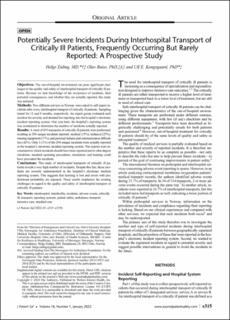| dc.contributor.author | Eiding, Helge | |
| dc.contributor.author | Røise, Olav | |
| dc.contributor.author | Kongsgaard, Ulf E. | |
| dc.date.accessioned | 2022-07-11T13:46:37Z | |
| dc.date.available | 2022-07-11T13:46:37Z | |
| dc.date.created | 2022-05-11T12:48:28Z | |
| dc.date.issued | 2022-01 | |
| dc.identifier.citation | Eiding, H., Røise, O., Kongsgaard, U.E. (2022) Journal of patient safety. Potentially Severe Incidents During Interhospital Transport of Critically Ill Patients, Frequently Occurring But Rarely Reported: A Prospective Study, 18 (1), E315-E319. | en_US |
| dc.identifier.issn | 1549-8417 | |
| dc.identifier.uri | https://hdl.handle.net/11250/3004562 | |
| dc.description.abstract | Objectives
The out-of-hospital environment can pose significant challenges to the quality and safety of interhospital transport of critically ill patients. Because we lack knowledge of the occurrence of incidents, their potential consequences, and whether they are actually reported, this study was initiated.
Methods
Two different services in Norway were asked to self-report incidents after every interhospital transport of critically ill patients. Sampling lasted for 12 and 8 months, respectively. An expert group evaluated each incident for severity and demand for reporting into the hospital’s electronic incident reporting system. One year later, the hospital’s reporting system was scrutinized to determine the number of incidents actually reported.
Results
A total of 455 transports of critically ill patients were performed, resulting in 294 unique incidents reported: medical (15%), technical (25%), missing equipment (17%), and personal failures and communication difficulties (42%). Only 3 (1%) of the 294 unique incidents were actually reported in the hospital’s electronic incident reporting system. The experts were inconsistent in which incidents should have been reported and to what degree checklists, standard operating procedures, simulation, and training could have prevented the incidents.
Conclusions
This study of interhospital transports of critically ill patients reveals a very high number of incidents. Despite this fact, these incidents are severely underreported in the hospital’s electronic incident reporting system. This suggests that learning is lost and errors with predominant probability are repeated. These results emphasize the existing challenges in regard to the quality and safety of interhospital transport of critically ill patients. | en_US |
| dc.language.iso | eng | en_US |
| dc.publisher | Wolters Kluwer Health, Inc. | en_US |
| dc.rights | Attribution-NonCommercial-NoDerivatives 4.0 Internasjonal | * |
| dc.rights.uri | http://creativecommons.org/licenses/by-nc-nd/4.0/deed.no | * |
| dc.subject | pasientsikkerhet | en_US |
| dc.subject | pasienttransport | en_US |
| dc.title | Potentially Severe Incidents During Interhospital Transport of Critically Ill Patients, Frequently Occurring But Rarely Reported: A Prospective Study | en_US |
| dc.type | Peer reviewed | en_US |
| dc.type | Journal article | en_US |
| dc.description.version | publishedVersion | en_US |
| dc.rights.holder | © 2020 The Author(s) | en_US |
| dc.subject.nsi | VDP::Medisinske Fag: 700 | en_US |
| dc.source.pagenumber | E315-E319 | en_US |
| dc.source.volume | 18 | en_US |
| dc.source.journal | Journal of patient safety | en_US |
| dc.source.issue | 1 | en_US |
| dc.identifier.doi | 10.1097/PTS.0000000000000769 | |
| dc.identifier.cristin | 2023509 | |
| cristin.ispublished | true | |
| cristin.fulltext | original | |
| cristin.qualitycode | 1 | |

